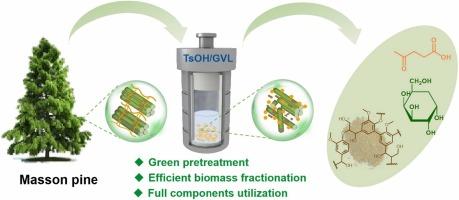Facilitated biomass fractionation by a p-toluenesulfonic acid-catalyzed γ-valerolactone pretreatment for co-production of glucose and levulinic acid from masson pine
IF 6.2
1区 农林科学
Q1 AGRICULTURAL ENGINEERING
引用次数: 0
Abstract
Development of green pretreatment strategies with excellent lignin removal ability is particularly important for masson pine biorefinery. γ-Valerolactone (GVL), as a green and recyclable solvent, has unique solvent characteristics to extract lignin. In this study, three acid catalysts, including sulfuric acid (H2SO4), hydrochloric acid (HCl) and p-toluenesulfonic acid (TsOH), were used to catalyze γ-valerolactone (GVL) pretreatment of masson pine. Among them, the TsOH-catalyzed GVL pretreatment achieved the highest lignin removal ratio and the best cellulose enzymatic hydrolysis yield. Under the optimized pretreatment conditions (150 ℃, 150 mM TsOH, GVL/H2O (4:1, w/w), 1 h), the lignin removal ratio reached 89.0 %, achieving a 72 h glucose yield of 87.1 % from the pretreated residues. The solvent lignins from pretreatment liquid was separated and characterized by NMR analysis. Meanwhile, the hexoses in pretreatment liquid were further converted into levulinic acid (LA) using the TsOH-catalyzed bi-phase reaction systems. This study gives insights into developing a biorefining process for the effective utilization of masson pine.

对甲苯磺酸催化γ-戊内酯预处理促进马尾松生物质分馏生产葡萄糖和乙酰丙酸
开发具有良好木质素去除能力的绿色预处理策略对马尾松生物炼制尤为重要。γ-戊内酯(GVL)作为一种绿色可回收溶剂,具有独特的提取木质素的溶剂特性。本研究采用硫酸(H2SO4)、盐酸(HCl)和对甲苯磺酸(TsOH)三种酸性催化剂催化γ-戊内酯(GVL)预处理马尾松。其中,tsoh催化的GVL预处理木质素去除率最高,纤维素酶解率最佳。在优化的预处理条件(150℃,150 mM TsOH, GVL/H2O (4:1, w/w), 1 h)下,木质素去除率达到89.0 %,72 h时,预处理残渣的葡萄糖收率为87.1 %。对预处理液中溶剂木质素进行了分离和NMR表征。同时,预处理液中的己糖通过tsoh催化的双相反应体系进一步转化为乙酰丙酸(LA)。本研究为马尾松生物精制工艺的有效利用提供了新的思路。
本文章由计算机程序翻译,如有差异,请以英文原文为准。
求助全文
约1分钟内获得全文
求助全文
来源期刊

Industrial Crops and Products
农林科学-农业工程
CiteScore
9.50
自引率
8.50%
发文量
1518
审稿时长
43 days
期刊介绍:
Industrial Crops and Products is an International Journal publishing academic and industrial research on industrial (defined as non-food/non-feed) crops and products. Papers concern both crop-oriented and bio-based materials from crops-oriented research, and should be of interest to an international audience, hypothesis driven, and where comparisons are made statistics performed.
文献相关原料
公司名称
产品信息
阿拉丁
γ-valerolactone (GVL)
阿拉丁
p-toluenesulfonic acid (TsOH)
阿拉丁
γ-valerolactone (GVL)
阿拉丁
p-toluenesulfonic acid (TsOH)
 求助内容:
求助内容: 应助结果提醒方式:
应助结果提醒方式:


